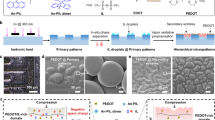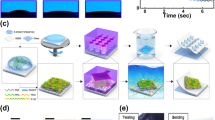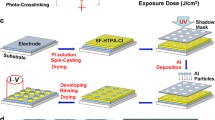Abstract
This chapter describes the implementation of Proton-fountain Electric-field-assisted Nanolithography (PEN) as a potential tool for fabricating nanostructures by exploiting the properties of stimuli-responsive materials. The merits of PEN are demonstrated using poly(4-vinylpyridine) (P4VP) films, whose structural (swelling) response is triggered by the delivery of protons from an acidic fountain tip into the polymer substrate. Despite the probably many intervening factors affecting the fabrication process, PEN underscores the improved reliability in the pattern formation when using an external electric field (with voltage values of up to 5 V applied between the probe and the sample) as well as when controlling the environmental humidity conditions. PEN thus expands the applications of P4VP as a stimuli-responsive material into the nanoscale domain, which could have technological impact on the fabrication of memory and sensing devices as well as in the fabrication of nanostructures that closely mimic natural bio-environments. The reproducibility and reversible character of the PEN fabrication process offers opportunities to also use these films as test bed for studying fundamental (thermodynamic and kinetic) physical properties of responsive materials at the nanoscale level.
Access this chapter
Tax calculation will be finalised at checkout
Purchases are for personal use only
Similar content being viewed by others
Notes
- 1.
Lattice models of polymer solutions are widely used for their simplicity and computational convenience. Their use for predicting solution properties of polymers solutions dates back to the 1940s.
- 2.
Since all phosphate salts are used in hydrated condition, the molecular weight (MW) should include the corresponding portion of water. For NaH2PO4 we should include one molecules of water, hence the MW is 137.99. On the other hand, for the Na2HPO4 we should consider 7 molecules of water (heptahydrate), which gives a MW of 268.07. Hence, if 13.8 and 0.036 g of NaH2PO4 and Na2HPO4 are used respectively, then we can quote the concentration of NaH2PO4 (the buffer strength) to be practically equal to 0.1 M.
- 3.
AFM XE-120 from Park Systems Inc.
- 4.
ibid.
References
K. Salaita, Y. Wang, and C. A. Mirkin, “Applications of dip-pen nanolithography,” Nat. Nanotechnol. 2, 145 (2007).
R. D. Piner, J. Zhu, F. Xu, S. Hong, and C. A. Mirkin, “Dip-Pen nanolithography,” Science 283, 661 (1999).
I. Tokarev and S. Minko, “Stimuli-responsive hydrogel thin films,” Soft Matter 5, 511 (2009).
L. Anson, “Membrane protein biophysics,” Nature 459, 343 (2009).
C. Ainsworth, “Stretching the imagination,” Nature 456, 696 (2008).
B. Bhushan, “Biomimetics: lessons from nature-an overview,” Phil. Trans. R. Soc. A 367, 1445 (2009).
I. Tokarev, M. Motornov, and S. Minko;, “Molecular-engineered stimuli-responsive thin polymer film: a platform for the development of integrated multifunctional intelligent materials,” J. Mater. Chem. 19, 6932 (2009).
C. Cofield, “Cell is mechanical device,” Am. Phys. Soc., APS News, Series II, 19, 4 (June 2010).
C. Wu, Y. Li, J. H. Haga, R. Kaunas, J. Chiu, F. Su, S. Usami, and S. Chien, “Directional shear flow and Rho activation prevent the endothelial cell apoptosis induced by micro patterned anisotropic geometry,” PNAS 104, 1254 (2007).
C. S. Chen, M. Mrksich, S. Huang, G. M. Whitesides, and D. E. Ingber, “Geometric control of cell life and death,” Science 276, 1425 (1997).
M. A. Greenfield, J. R. Hoffman, M. Olvera de la Cruz, and S. I. Stupp, “Tunable mechanics of peptide nanofiber gels,” Langmuir 26, 3641 (2010).
M. M. Stevens and J. H. George, “Exploring and engineering the cell surface interface,” Science 310, 1135 (2005).
S. Maeda, Y. Hara, T. Sakai, R. Yoshida, and S. Hashimoto, “Self-walking gel,” Adv. Mater. 19, 3480 (2007).
T. K. Tam, M. Ornatska, M. Pita, S. Minko, and E. Katz, “Polymer brush-modified electrode with switchable and tunable redox activity for bioelectronic applications,” J. Phys. Chem. C 112, 8438 (2008).
D. Wang, I. Lagzi, P. J. Wesson, and B. A. Grzybowski, “Rewritable and pH-sensitive micropatterns based on nanoparticle ‘Inks’,” Small 6, 2114 (2010).
J. Ruhe, M. Ballauff, M. Biesalski, P. Dziezok, F. Grohn, D. Johannsmann, N. Houbenov, N. Hugenberg, R. Konradi, S. Minko, M. Motornov, R. R. Netz, M. Schmidt, C. Seidel, M. Stamm, T. Stephan, D. Usov, and H. Zhang, “Polyelectrolyte brushes” in: “Polyelectrolytes with Defined Molecular Architecture,” M. Schmidt Ed. Adv. Polym. Sci. 165, 79 (2004).
C. Liu, H. Qin, and P. T. Mather, “Review of progress in shape-memory polymers,” J. Mater. Chem. 17, 1543 (2007).
R. Yoshida, K. Uchida, Y. Kaneko, K. Sakai, A. Kikuchi, Y. Sakurai, and T. Okano, “Comb-type grafted hydrogels with rapid deswelling response to temperature changes,” Nature 374, 240 (1995).
T. Suzuki, S. Shinkai, and K. Sada, “Supramolecular crosslinked linear poly(trimethylene iminium trifluorosulfonimide) polymer gels sensitive to light and thermal stimuli,” Adv. Mater. 18, 1043 (2006).
B. A. Evans, A. R. Shields, R. Lloyd Carroll, S. Washburn, M. R. Falvo, and R. Superfine, “Magnetically actuated nanorod arrays as biomimetic cilia,” Nano Lett. 7, 1428 (2007).
O. Ikkala and G. Brinke, “Functional materials based on self assembly of polymeric supramolecules,” Science 295, 2407 (2002).
M. Kaholek, W. K. Lee, B. LaMattina, K. C. Caster, and S. Zauscher, “Fabrication of stimulus-responsive nanopatterned polymer brushes by scanning-probe lithography,” Nano Lett. 4, 373 (2004).
X. Liu, S. Guo, and C. A. Mirkin, “Surface and site-specific ring-opening metathesis polymerization initiated by dip-pen nanolithography,” Angew. Chem. Int. Ed. 42, 4785 (2003).
Y. Okawa and M. Aono, “Nanoscale control of chain polymerization,” Nature 409, 683 (2001).
S. P. Sullivan, A. Schnieders, S. K. Mbugua, and T. P. Beebe Jr., “Controlled polymerization of substituted diacetylene self-organized monolayers confined in molecule corrals,” Langmuir 21, 1322 (2005).
Y. Okawa, D. Takajo, S. Tsukamoto, T. Hasegawa, and M. Aono, “Atomic force microscopy and theoretical investigation of the lifted-up conformation of polydiacetylene on a graphite substrate,” Soft Matter 4, 1041 (2008).
P. Calvert, “Hydrogels for soft machines,” Adv. Mater. 21, 743 (2009).
P. J. Flory and J. Rehner, “Statistical mechanics of cross-linked polymer networks I. Rubberlike elasticity,” J. Chem. Phys. 11, 512 (1943).
P. J. Flory and J. Rehner, “Statistical mechanics of cross-linked polymer networks II. Swelling,” J. Chem. Phys. 11, 521 (1943).
K. Huang, “Statistical Mechanics,” Wiley, New York, 2nd Ed. (1987).
F. P. Chinard and T. Enns, “Osmotic pressure,” Science 124, 472 (1956).
P. J. Flory, “Principles of Polymer Chemistry,” Cornell University Press, Oxford (1969).
Y. Osada and J. Gong, “Soft and wet materials: Polymer gels,” Adv. Mater. 10, 827 (1998).
L. D. Landau and E. M. Lifshitz, “Statistical Physics”, Elsevier, New York, 3rd Ed., Part 1, pp. 72, 267 (2006).
P. J. Flory, “Thermodynamics of high polymer solutions,” J. Chem. Phys. 10, 51 (1942).
P. J. Flory, “Statistical mechanics of swelling of network structures,” J. Chem. Phys. 18, 108 (1950).
W. Hu and D. Frenkel, “Lattice-model study of the thermodynamic interplay of polymer crystallization and liquid–liquid demixing,” J. Chem. Phys. 118, 10343 (2003).
A. Yu. Grosberg and A. R. Khokhlov, “Giant Molecules. Here, There and Everywhere,” Academic Press, New York (1997).
D. Woo, “Spectroscopic Ellipsometry Studies of Polymers on Silicon Wafer,” Thesis for the Master degree in Physics, Portland State University, Portland, OR (2009).
C. Maedler, H. Graaf, S. Chada, M. Yan, and A. La Rosa, “Nano-structure formation driven by local protonation of polymer thin films”, Proc. SPIE, 7364, 736409-1 (2009).
X. Wang, “Characterization of Mesoscopic Fluid-Like Films with the Novel Shear-Force/Acoustic Microscopy,” Thesis for the Master degree in Physics, Portland State University, Portland, OR (2010).
X. Wang, X. Wang, R. Fernandez, L. Ocola, M. Yan, and A. La Rosa, “Electric field-assisted dip-pen nanolithography on poly(4-vinyl pyridine) films,” ACS Appl. Mater. Interface 2, 2904–2909 (2010).
J. Lahann, S. Mitragotri, T. Tran, H. Kaido, J. Sundaram, I. S. Choi, S. Hoffer, G. A. Somorjai, and R. Langer, “A reversibly switching surface,” Science 299, 371 (2003).
I. S. Lokuge and P. W. Bohn, “Voltage-tunable volume transitions in nanoscale films of poly(hydroxyethyl methacrylate) surfaces grafted onto gold,” Langmuir 21 , 1979 (2005).
T. Tanaka, I. Nishio, S. Sun, and S. Ueno-Nishio, “Collapse of gels in an electric field,” Science, 218, 467 (1982).
M. Annakaand and T. Tanaka, “Multiple phases of polymer gels,” Nature 355, 430 (1992).
A. Matsuyama, “Volume phase transitions of smectic gels,” Phys. Rev. E 79, 051704 (2009).
W. Xue, and I. W. Hamley, “Thermoreversible swelling behaviour of hydrogels based on N-isopropylacrylamide with a hydrophobic comonomer,” Polymer 43, 3069 (2002).
A. Richter, G. Paschew, S. Klatt, J. Lienig, K. Arndt, and H. P. Adler, “Review on hydrogel-based pH sensors and microsensors,” Sensors 8, 561 (2008).
T. Tanaka, D. Fillmore, S.-T. Sun, I. Nishio, G. Swislow, and A. Shah, “Phase transitions in ionic gels,” Phys. Rev. Lett. 45, 1636 (1980).
A. Suzuki and T. Tanaka, “Phase transition in polymer gels induced by visible light,” Nature 346, 345 (1990).
F. Ilmain, T. Tanaka, and E. Kokufuta, “Volume transition in a gel driven by hydrogen bonding,” Nature 349, 400 (1991).
S. Juodkazis, N. Mukai, R. Wakaki, A. Yamaguchi, S. Matsuo, and H. Misawa, “Reversible phase transitions in polymer gels induced by radiation forces,” Nature 408, 178 (2000).
M. Shibayama and T. Tanaka, “Small-angle neutron scattering study on weakly charged temperature sensitive polymer gels,” J. Chem. Phys. 97, 6842 (1992).
S. Hong and C. A. Mirkin, “A nanoplotter with both parallel and serial writing capabilities,” Science 288, 1808 (2000).
C. Maedler, S. Chada, X. Cui, M. Taylor, M. Yan, and A. La Rosa, “Creation of nanopatterns by local protonation of P4VP via dip pen nanolithography.” J. Appl. Phys. 104, 014311 (2008).
C. Maedler, “Applying Different Modes of Atomic Force Microscopy for the Manipulation and Characterization of Spatially Localized Structures and Charges,” Diploma Thesis for the academic degree of Diplom Physiker; Faculty of Natural Sciences Institute of Physics, Chemnitz University of Technology (2009).
M. Nonnenmacher, M. P. O’Boyle, and H. K. Wickramasinghe, “Kelvin probe force microscopy,” Appl. Phys. Lett. 58, 2921 (1991).
M. Schenk, M. Futing, and R. Reichelt, “Direct visualization of the dynamic behavior of water meniscus by scanning electron microscopy,” J. Appl. Phys. 84, 4880 (1998).
L. M. Demers, D. S. Ginger, Z. Li, S.-J. Park, S.-W. Chung, and C. A. Mirkin, “Direct patterning of modified oligonucleotides on metals and insulators by dip-pen nanolithography,” Science 296,1836 (2002).
S. Rozhok, P. Sun, R. Piner, M. Lieberman, and C. A. Mirkin, “AFM study of water meniscus formation between an aFM tip and NaCl substrate,” J. Phys. Chem. B 108, 7814 (2004).
P. E. Sheehan and L. J. Whitman, “Thiol diffusion and the role of humidity in ‘dip pen nanolithography’,” Phys. Rev. Lett. 88, 156104 (2002).
Z. Zheng, M. Yang, and B. Zhang, “Reversible nanopatterning on self-assembled monolayers on gold,” J. Phys. Chem. C 112, 6597 (2008).
J.-W. Jang, D. Maspoch, T. Fujigaya, and C. A. Mirkin, “A ‘molecular eraser’ for dip-pen nanolithography,” Small 3, 600 (2007).
Y. Li, B. W. Maynor, and J. Liu, “Electrochemical AFM ‘Dip-pen’ nanolithography,” J. Am. Chem. Soc. 123, 2105 (2001).
F. C. Simeone, C. Albonetti, and M. Cavallini, “Progress in micro- and nanopatterning via electrochemical lithography,” J. Phys. Chem. C 113, 18987 (2009).
R. Maoz, E. Frydman, S. R. Cohen, and J. Sagiv, “’Constructive nanolithography’: inert monolayers as patternable templates for in-situ nanofabrication of metal-semiconductor-organic surface structures: a generic approach,” Adv. Mater. 12, 725 (2000).
Z. Zheng, M. Yang, and B. Zhang, “Constructive nanolithography by chemically modified tips: nanoelectrochemical patterning on SAMs/Au,” J. Phys. Chem. C 114, 19220 (2010).
Y. Cai and B. M. Ocko, “Electro pen nanolithography,” J. Am. Chem. Soc. 127, 16287 (2005).
D. Chowdhury, R. Maoz, and J. Sagiv, “Wetting driven self-assembly as a new approach to template-guided fabrication of metal nanopatterns,” Nano Lett. 7, 1770 (2007).
A. Zeira, D. Chowdhury, S. Hoeppener, S. T. Liu, J. Berson, S. R. Cohen, R. Maoz, and J. Sagiv, “Patterned organosilane monolayers as lyophobic−lyophilic guiding templates in surface self-assembly: monolayer self-assembly versus wetting-driven self-assembly,” J. Langmuir 25, 13984 (2009).
P. Yao, G. J. Schneider, J. Murakowski, and D. W. Prather, “Chemical lithography,” J. Vac. Sci. Technol. B 24, 2553 (2006).
K. Shanmuganathan, J. R. Capadona, S. J. Rowan, and C. Weder, “Stimuli-responsive mechanically adaptive polymer nanocomposites,” ACS Appl. Mater. Interface 2, 165 (2010).
R. Klajn, P. J. Wesson, K. J. M. Bishop, and B. A. Grzybowski, “Writing self-erasing images using metastable nanoparticle ‘Inks’,” Angew. Chem. Int. Ed. 48, 7035 (2009).
S. V. Kalinin and N. Balk, “Local Electrochemical functionality in energy storage materials and devices by scanning probe microscopies: status and perspectives,” Adv. Mater. 22, E193–E209 (2010).
A. A. Tseng, A. Notargiacomo, and T. P. Chen, “Nanofabrication by scanning probe microscope lithography: a review,” J. Vac. Sci. Technol. B 23, 877 (2005).
A. A. Tseng, A. Notargiacomo, T. P. Chen, and Y. Liu, “Profile uniformity of overlapped oxide dots induced by atomic force microscopy,” J. Nanosci. Nanotechnol. 10, 4390 (2010).
K. B. Jinesh and J. W. M. Frenken, “Capillary condensation in atomic scale friction: how water acts like a glue,” PRL 96, 166103 (2006).
P. J. Feibelman, “The first wetting layer on a solid,” Physics Today 63, 34 (2010).
E. Kapetanakis, A. M. Douvas, D. Velessiotis, E. Makarona, P. Argitis, N. Glezos, and P. Normand, “Hybrid organic–inorganic materials for molecular proton memory devices,” Org. Electron. 10, 711 (2009).
E. Kapetanakis, A. M. Douvas, D. Velessiotis, E. Makarona, P. Argitis, N. Glezos, and P. Normand, “Molecular storage elements for proton memory devices,” Adv. Mater. 20, 4568 (2008).
S. M. Haile, D. A. Boysen, C. R. Chisholm, and R. B. Merle, “Solid acids as fuel cell electrolytes,” Nature 410, 910 (2001).
T. Norby, “The promise of protonics,” Nature 410, 877 (2001).
P. M. Gilbert, K. L. Havenstrite, K. E. G. Magnusson, A. Sacco, N. A. Leonardi, P. Kraft, N. K. Nguyen, S. Thrun, M. P. Lutolf, and H. M. Blau, “Substrate elasticity regulates skeletal muscle stem cell self-renewal in culture,” Science 329, 1078 (2010).
Author information
Authors and Affiliations
Corresponding author
Editor information
Editors and Affiliations
Rights and permissions
Copyright information
© 2011 Springer Science+Business Media, LLC
About this chapter
Cite this chapter
La Rosa, A., Yan, M. (2011). Proton-fountain Electric-field-assisted Nanolithography (PEN). In: Tseng, A. (eds) Tip-Based Nanofabrication. Springer, New York, NY. https://doi.org/10.1007/978-1-4419-9899-6_8
Download citation
DOI: https://doi.org/10.1007/978-1-4419-9899-6_8
Published:
Publisher Name: Springer, New York, NY
Print ISBN: 978-1-4419-9898-9
Online ISBN: 978-1-4419-9899-6
eBook Packages: EngineeringEngineering (R0)




